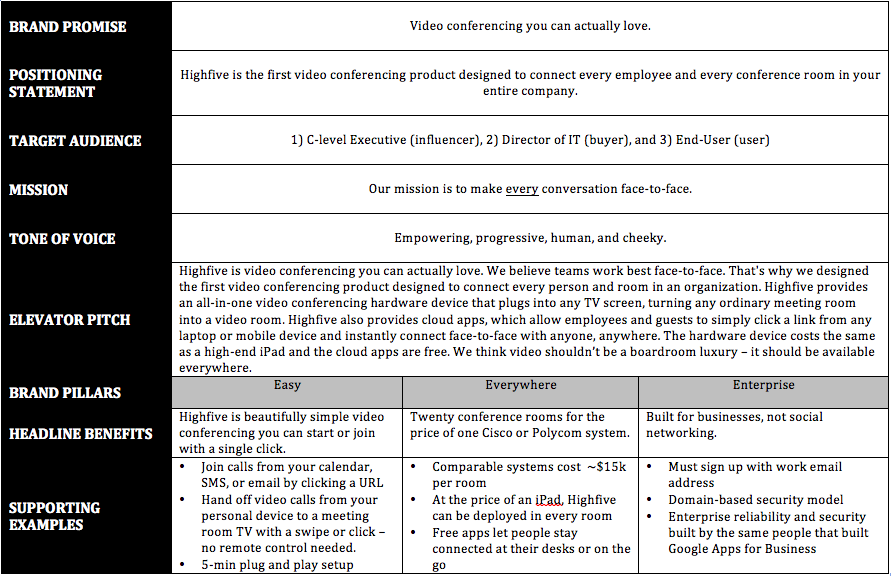Dear Founders: Start with Messaging
A Messaging Framework and Template for Founders Building SaaS Brands
Dear founders: This article is intended to help you clearly understand why your messaging framework is so critical to successfully launching your company and growing it over time. To help you crystallize your startup’s value proposition, galvanize your team, and successfully go to market, we’ll cover these essential topics:
Your foundational messaging priorities (including value proposition and buyer personas)
- A sample messaging framework template
- How to build consensus among your team’s key stakeholders
- The core components of your messaging framework
- How to test and evolve messaging over time
Ready? Let’s get started.
What Is a Strategic B2B Messaging Framework?
Your messaging framework is the basis of how you think about, and talk about, your startup company, what problems it solves, and the audience to which you want to speak. A successful messaging framework includes the core foundation for how you communicate, your key differentiators from your competitors, and how you market and sell your products.
How Does a Strategic Messaging Framework Help an Organization?
Messaging is a critical foundation for so many early-stage activities, including:
- Branding: Creating an identity and a brand voice for your company that is distinct and easy to communicate quickly
- Creating Buyer Personas: The profile of your target customer, encompassing their roles, their pain points, and the solutions your company will provide
- Initial Content Marketing: Content marketing can grow your business by driving website traffic and leads, answering key questions, and positioning your startup as a thought leader
- General Availability Launching: With effective messaging, you can clearly convey the value of key launches and drive adoption of new products and enhancements
- Finding Design Partners: A key to long-term success is engaging design partners who can provide high-quality product feedback during development and testing phases to improve launches
...and many more.
The traditional concept of the “value proposition” clearly explains to prospects what value you offer, and why they should do business with you, rather than with your competitors. To clarify, we’re not talking about taglines, which are quick-hit slogans using figurative language for elevator-pitch-style conversations. While you may come up with flashy taglines, those are for style, while your value proposition communicates the substance of your startup and how you’ll make your customers’ lives better.
You will communicate the substance through your messaging pillars, supporting examples, and positioning statement, which we’ll cover in our template below. And your overall messaging framework helps you come to the first iteration of your messaging relatively quickly by answering the existential question: Why do we deserve to exist?
A successful messaging framework puts you in the best position to not only start acquiring users, but also to create a brand message that will resonate with them. Your brand messaging framework needs to explain:
- Initial Adoption: Why should anyone bother to try your product?
- Continued Investment: Why should potential customers invest in your platform?
- Switching Costs: Why should customers navigate any switching costs from perceived competitors?
A successful brand messaging framework, along with your persona document, should help you:
- Empower: Your teams to rally around a clear purpose and identity, eventually informing every piece of content you create
- Prioritize: The needs of core users
- Increase productivity: By removing approvals on site changes, sales decks, or even blog posts from your marketing team
- Drive alignment: By being a constant reminder of the public promises you’ve made to end-users
What Should Not Be Part of Your Initial Messaging Framework?
Here’s the thing: building the messaging framework isn’t a marketing exercise. Below are some items that should not be part of your initial brand messaging framework conversations:
- Talking Points for Salespeople: Compiling impactful selling points for the most eager members of your sales teams is a key part of going to market, but specific messaging for sales goes in your first sales deck (and for growing organizations, a key task for product marketing teams), not the focus of your foundational messaging house
- In-House Style Guide: While it’s important to have a consistent style guide, you can worry about Oxford commas after you’ve completed your brand messaging framework
- A Series of Buzzwords: The project isn’t for your marketing lead or exec team to create a series of buzzwords in a vacuum
You need to do some discovery to uncover the promise you can make to customers today. You may have a much grander vision for your product or platform. That’s fine. Messaging evolves.
Sound interesting? Let’s walk through the simplified version of building your first brand messaging framework. If you’re not familiar, this format is pretty standard.
An Example of a Messaging Framework Template

But marketing experts like Reify suggest building a messaging framework from the bottom up. Based on the above image, I have to agree. So, with this template, here’s the actual order of how to build a messaging framework.
Get the Template

A Process for Creating Your Startup’s Brand Messaging
- Choose the Minimum Viable Stakeholders to Start: This probably includes the CEO, product leader, CTO, and the customer-facing head of support, marketing, or community. No need for the group to be professional copywriters or content creators. Each individual brings a different lens to the exercise. Some of these discussions will get heated. My suggestion is to schedule a minimum of three group meetings in order to truly gain consensus.
- Start with Target Audience and Tone of Voice: If you don’t have product/market fit, then you probably just have one core persona (or should). Get specific here. Very few products are relevant to “all developers.” There are probably some technical criteria for success, such as existing tools, languages, frameworks, size of engineering org, etc. You probably also have a tone of brand voice (e.g. playful, professorial, informative, straight-forward). Aim to gain consensus around these two sections with the stakeholders in the room. This should be a fast exercise as most of it should be fairly uncontroversial.
- Now work on Brand Pillars and Supporting Examples: This is harder. Supporting examples might include common comments or frequently cited killer product features from early users, customers, and press that you can refine into core message pillars that inform the basis of your framework. Look for patterns in what others claim is the reason you’re different. They may not support your aspirations for the product, but you’ll earn that in the future. For now, understand in real terms what you’re solving for and be willing to take those supposedly sacred early message pillars and, if need be, burn your totems. Once you’ve got some bullet points of real-world supporting examples, try to sort them into three thematic buckets. These themes then become your brand pillars. Do not start wordsmithing yet. These are just “idea buckets.”
It’s likely that it took you a while to gain consensus on your core messaging and supporting examples. It might’ve even taken multiple meetings. Don’t take shortcuts here. Gaining consensus (or at least willing compromise) means your founders and core executives are aligned and will use this to inform their direct reports. This next section is a good time to set new meetings and break out the thesaurus.
Commence Wordsmithing!
The point of the next stage of the exercise is not to sprinkle all your good teamwork and “idea buckets” with nonsense adjectives. Everyone thinks their product is the “first,” “stellar,” and “best.” That might be true. But if that’s the case, just say what you need to and let the product speak for itself.
- Headline Benefits (25 words): Use your brand’s tone of voice and munge each brand pillar theme (and in some cases the core supporting example) into a single sentence. Limit this to 25 words max. This encourages brevity. Saying something quickly and plainly is the most respectful thing you can do for end-users. Now check your work. Could the headline benefits be applied to other products? Competitors? Literally Google your benefit statements and see if you can further differentiate.
- Elevator Pitch (55 words): The elevator pitch is two to three sentences that speak to your target audience. In this section, munge together the best parts of your headline benefits. This is sometimes referred to as your boilerplate. I limit this to 55 words max and it’s always written in 3rd person objective point of view.
- Positioning Statement (25 words): This is often just used internally, but it’s still good to craft in Mad Libs style as a single sentence at max 25 words. e.g. "For [target audience], our product provides [brand pillars 1,2,3] because [short-form headline benefits]."
- Brand Promise (10 words): This is basically your tagline. Use all you’ve wordsmithed above, reduce word count even further, and make it pithy. It doesn’t even have to be a proper sentence. e.g. “GitHub: How people build software.”
Why We're the Leading Dev-First Investor
Learn how to unlock success for your startup from pioneers in the developer-first space. We send the best strategies, tools, and industry updates directly to your inbox.
Mission Statement: What is the Big Hairy Goal?
Some early startups just build their benefits and elevator pitch and create their mission in a completely separate exercise. That’s fine, but the point is you need to be ready to discuss a higher purpose and you can’t just say “Making the world a better place through [list of features].”

Crafting your mission statement is the time to unleash the BHAG! (big hairy audacious goal) All your effort to deliver customer benefits and value should roll up into something really meaningful.
This is where you can add the aspirational goals for the org. Create a single sentence that rallies your employees, users, and community. e.g. “Environmental Defense Fund: To preserve the natural systems on which all life depends.”
You Are not Done
Once you’ve come to an agreement on the above (or even most of the above), you should have a working messaging framework. This needs to be revisited as you release new products, launch platform efforts, or when there are major inflection points in the company’s growth. But for now, you’ve got what Betty Junod calls, “your source of truth,” which you can use to inform your marketing strategy, content strategy, and overall brand strategy going forward. Here are some common ways to cascade the brand messaging framework:
- Headline Benefits: These three sentences often form the three hero images and text on an early company’s website. They’re also incorporated into site nav, given separate landing pages and case studies, can be made into separate nurturing campaigns, become paid text campaigns, and can be used as swappable modules in the sales deck depending on a customer’s needs. Even if they can’t be recited in their perfectly wordsmithed form, your employees and community should be able to repeat the key tenets of these headline benefits.
- Elevator Pitch: The elevator pitch is generally the sentence that gets appended as the boilerplate on a press release, is at the top of your “About” page, and is carried over to your company LinkedIn, Crunchbase, AngelList, and gets added to signature lines for every employee.
- Positioning Statement & Brand Promise: These often appear on field marketing banners and signage, SWAG, short-form descriptions like the corporate Twitter description and meta tags, presentation titles, and as snippets.
- Mission: There’s a reason most messaging frameworks offer this at the top of the document and move on to the “how” and “why” your business exists. Your company’s mission statement can be used at all-hands, off-sites, in larger community and user conferences, and becomes the rallying cry that communicates your brand values and positions you as a positive player in a much larger industry or global narrative.
Testing Your Messaging Framework
Once you’ve landed on a messaging framework and your execs have shared it with the team, you’ve given everyone the tool and permission to build, publish and sell on theme. This should reduce bottlenecks and cut time on manager approvals for your various marketing campaigns. This alone is validation that the time spent on a messaging framework is valuable.
Further analysis of public comments, customer feedback, site engagement, and search campaigns etc. will also tell you what is effective and what needs further tweaking, especially as you work on content creation to communicate your company’s value and potentially drive inbound leads. In essence, you’re never quite done with messaging, but you need to start now. In time, the hard work you do now will eventually inform marketing messaging frameworks, product messaging frameworks, and many other important strategic and tactical communications assets.
If you understand what it takes to build a sustainable and useful developer or enterprise startup, then you also understand that all aspects of your company will continue to evolve over time. Messaging is no exception, but when you get it right, you clear away confusion, empower your go-to-market teams, and lay the foundation for a strong brand.
Examples of Great SaaS Company Messaging
Looking for more messaging framework examples and additional materials on messaging and positioning? The Heavybit library contains additional articles, videos, and other content including presentations on:
- Product Positioning Via Product-Market Fit
- Building a Better Core Pitch
- Getting to a Value Proposition
You might find more additional inspiration in these additional resources:
- A Product Positioning Exercise
- How to Build a Strategic Narrative
- The Making of a Great Strategic Narrative
Interested in joining Heavybit? Our program is the only one of its kind to focus solely on taking developer products to market. Need help with developer traction, product-market fit, and customer development? Apply today and start learning from world-class experts.
Subscribe to Heavybit Updates
You don’t have to build on your own. We help you stay ahead with the hottest resources, latest product updates, and top job opportunities from the community. Don’t miss out—subscribe now.
Content from the Library
Three Questions to Answer Before Announcing a New Feature
Announcing a new feature can be just as important to your company as a full-blown product launch. In this article, we’ll cover...
How to Craft Your First Customer Case Study
So you have an early cohort of happy customers, and you’d like to share their successes with leads and prospects to help attract...
